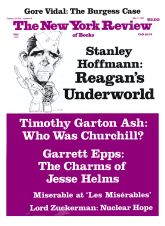In response to:
Fingerprinting Shakespeare from the February 12, 1987 issue
To the Editors:
Ernst Honigmann is the sixth academic so far to explain away Edmund Ironside as an imaginary plagiarism at an imaginary date [NYR, February 12]; I have already refuted such fantasies in a new preface for my second edition (Wildwood House, 1986). He has also missed the announcement by the New York documents expert Charles Hamilton that the Ironside MS is indeed in Shakespeare’s own handwriting. Any such attribution, once accepted, would annihilate Honigmann’s own thirty-year-old theories about early Shakespeare; so he should surely have declared that interest, especially since some undisclosed factor has so blatantly distorted his reasoning and his judgment.
Thus he omits all mention of the play’s demonstrably Shakespearean level of linguistic inventiveness, a quality for which plagiarists are not normally noted. He concedes however that Ironside’s 260 coinages assigned by the Oxford English Dictionary to Shakespeare “might yet prove significant.” Meanwhile, forget it. Who cares whether a dozen “combinations” which are “not unlike image clusters, unconsciously associated words that reappear in different works by the same author,” as Honigmann himself incautiously puts it, occur in both Ironside and the canon? Why bother if “something quite like the most famous Shakespearean cluster” appears in Ironside? So does the equally Shakespearean “blot” cluster; no need to notice that. No matter if, as Honigmann himself demonstrates, spellings in the Ironside MS match those in Shakespeare’s More MS. No doubt stage directions “could be important”; so assume that they are not. The Ironside case could have been given a “tremendous lift” by assurances that its admittedly striking parallels do not occur outside Shakespeare; so ignore all the assurances I cite to that effect.
Now we are ready to turn a deaf ear to the crucial question of date. Begin by rejecting the consensus of every serious Ironside researcher who ever lived, as summarized and supplemented in my twenty pages of fact and argument in support of 1590 or earlier. Next, consider its total of 2,500 different lexical words, of which the OED. cites some 10 percent from Shakespeare and all the rest (except one) from 1589 or earlier. Contrive to resist the selfevident inferences about authorship and date. Instead, jettison 2,499 words and salvage the sole exception, “Braggadochios,” first cited from Spenser, The Faerie Queene I–III, published in 1590. Assume that the OED. date is infallibly right in this one instance, while simultaneously asserting that “the OED is often up to fifty years too late with its first citations.” Discount the admitted fact that Books I–III had been circulating in manuscript since 1587. Invent the new fact that “Braggadochios…meant nothing to the general public before 1590.” Pretend that this date can somehow be stretched to accommodate an unevidenced hypothesis of “plagiarism” from publications unknown before 1594, or else from whatever imaginary plays, performances and attendances this hypothesis may require. Feel free, above all, to treat Ironside and its advocates with consistent contempt or condescension. Now comes the knock-down argument. Of course William Shakespeare cannot conceivably ever have perpetrated a play which was destined to be dismissed by Ernst Honigmann as “awful stuff” four centuries later, even though there was no thought of pleasing him when it was written. All this will surely serve to show the literary world exactly how unassuming and unbiased the academic experts are; quite unlike Mr. Sams.
Eric Sams
Surrey, England
Ernst Honigmann replies:
Mr. Sams tells us that six academics have rejected his theories about Edmund Ironside, but does not see why. Do all six have an undeclared interest in suppressing new information about Shakespeare? For more than two hundred years specialists have searched high and low for new Shakespeare documents, particularly documents in the dramatist’s handwriting; when the facts were presented carefully, in a manner that inspired confidence, new documents have not failed to win a place in the Shakespeare canon, whether or not they contradicted previously held theories. The three pages added by “Hand D” to the play Sir Thomas More are a case in point. These three pages are now pretty generally accepted as Shakespeare’s—so the “Shakespeare establishment” can respond positively to new theories not unlike the one proposed by Mr. Sams. The fact that Ironside has been given a different reception is surely significant.
My review, by the way, was sent in in July 1986, and was in proof before Mr. Hamilton asserted that Ironside is in Shakespeare’s handwriting, and before Mr. Sams issued his second edition.
This Issue
May 7, 1987



